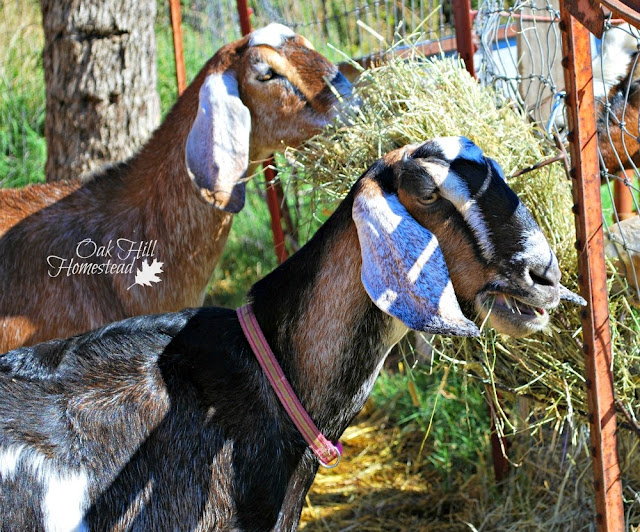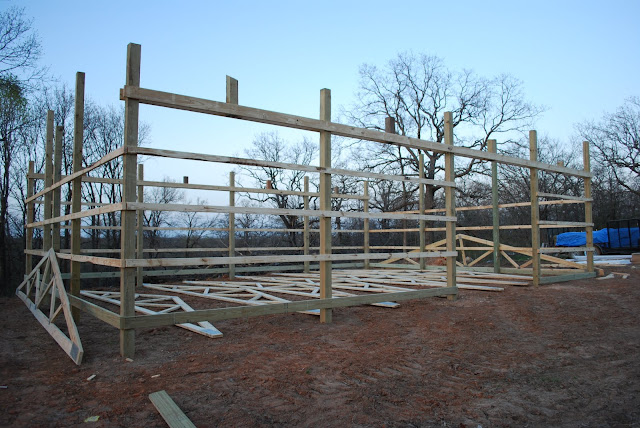If you are a new or a hope-to-be homesteader, you may be wondering what your first homesteading projects should be.
With so many homestead activities and livestock to choose from, where on earth should you start? Learn how to make a plan for your homestead.
How to make a homestead plan
What is a homestead? A homestead is a house surrounded by land that is devoted to crops and livestock. [Source] However, the "modern homesteader" term is used to describe people who want to reconnect with the land, grow their own food or live a simpler, less-stressful life.
Although a homestead can include many acres with a barn and a farmhouse, chickens and pigs and a milk cow, a root cellar and more, a modern homestead can be a small piece of property with or without animals.
Whether or not you're a new homesteader, you might be wondering "where do I begin" or "where do I go from here?"
There are so many directions you could go, and it's easy to get in over your head!
The thing is, "homesteading" has so many directions and you probably feel as if you should be an expert in all of them: livestock, gardening, preserving, and even more.
But if you jump in with both feet, starting a one-acre garden, getting chickens and other livestock, and deciding that everything you cook for your family will be from scratch, you'll find yourself overwhelmed in double-quick time.
So where do you start? How do you know what to focus on?
Even if you've been homesteading for awhile, this is a good time to sit down and analyze what's working, what isn't, and where you want to go from here.
Define your reason for homesteading
Start by writing down your reason for homesteading. Dig deep to discover why you want to homestead.
It might be one of these, or it might something completely different.
- to be as self-sufficient as possible, to be independent
- to supply the healthiest meat possible for your family to eat
- to grow fresh, organic food for your family
- to produce your family's milk and eggs
- to grow or produce an expensive item you use or consume often
- to grow the best tomatoes or peaches or [insert your "favorite" here]
- to grow and preserve enough food to last a year, every year
- to live an all-around healthy lifestyle
- to live off-grid
- or some other reason - this is your reason to homestead so figure out your own purpose
By discovering and defining your own purpose you'll know which direction you need to go. Write it down, and don't lose sight of your primary goal.
Find your passion
Don't confuse this with defining your purpose. They are not the same, although your passion is probably closely related to your purpose..
Your purpose is the reason behind what you're doing. Your passion is what you love doing, something you wish you could do constantly.
You probably know the answer to this question without thinking too hard.
Do you enjoy caring for animals more than gardening, or do you prefer working with soil and plants? Perhaps your interests lie inside your home, creating a simple and fulfilling life for your family?
Perhaps your children are in 4-H or FFA and your passion is breeding registered dairy goats or showing rabbits.
Or maybe your passion is to remove toxins and chemicals from your home by replacing purchased products with healthy alternatives that you've learned to make yourself, or you want learn to cook more foods from scratch.
Do you have enough land
Some homestead activities require a lot of land. If you have acreage, for instance, you can raise larger animals or have a larger garden than if you live on a suburban lot.
Like it or not, you can't raise cattle on one acre. But you can have smaller livestock such as chickens, rabbits and goats.
And you can live a simple, self-reliant life no matter where you live, so don't let your lack of space hold you back!
Be sure to check your local ordinances too. You won't be able to have bees or raise chickens if your town or homeowners' association doesn't allow it.
What do you want to do on your homestead?
Next, let's narrow down what you want to focus on, and be more specific about what you want to do.
For instance, if your goal is to raise all of your family's meat, where will you begin?
A steer is an 18-month commitment, a hog is about ten months, while broiler chickens take just eight to ten weeks.
But don't start them all at the same time! You'll definitely be in over your head and ready to throw in the towel in record time.
Choose just one species at first and move on from there.
Chickens are probably the easiest and definitely the quickest to raise, and are a good place to begin.
If your goal is to have home-raised chicken on the table once a week, you'll need to raise 52 chickens each year. If your space is limited, you might want to raise two batches of 26 broiler chickens instead of doing it all at once.
Here are the ten things you should consider and decide before raising meat chickens
Or, if one of your goals is to have laying hens, you can base the number of chicks you get on how many eggs you'll use per week. Hens lay an average of one egg per day.
While young hens (called pullets) usually continue to lay during their first winter, older hens usually take a break until spring. You can get around this "dry spell" by adding a few new chicks to your laying flock each year. (Or you can freeze eggs in the fall so you'll have some in reserve for holiday baking.)
If you want to sell excess eggs and raise a little cash as well, you would add more chicks. Just remember that hens need at least four square feet per bird and consider the amount of space you have.
Again, start small. You can add more chickens - plus ducks and geese and guineas and a turkey for your Thanksgiving meal - in the future, little by little.
You'll find all my chicken-raising posts here.
Or if your focus is on gardening and growing all or most of your family's vegetables and fruit, you're in luck! You'll find all of my gardening posts here.
How to make a homestead plan
Now that you know what your purpose and your passion are, you are ready to make a plan and start (or restart) your homestead journey.
For now, start by writing down all of your homestead dreams. Make a long list of all the things you want to do in the future.
Dream big, but then narrow down your focus until you are thinking small. Decide which projects you want to work on first, then prioritize them, break them down into tasks, and decide where you want to begin.
Remember to start small, learn all you can about what you're doing, and add things as you feel more confident.
First year homestead projects and goals
Don't buy an animal before you have the facilities to house and care for it! Chickens need a coop. Goats need a shelter and good fencing. (This is the best fencing for goats in my opinion.)
Larger livestock need strong fences. All animals need feeders and waterers and equipment.
So concentrate on "facilities" your first year. I can tell you from experience that the best way to decide where to put your chickens or your garden or your orchard is to live with your land for awhile.
Notice where the sun rises and sets, and which way the prevailing winds blow. Will that big oak tree throw too much shade on the garden? Remember, trees grow larger with time and the shadow will grow too.
That same big oak tree could provide some summer shade for your goats, but I'd put the fence in between the tree and the goats so they won't kill it by eating all the bark off of it.
Don't make the mistake we did of putting a large picture window on the south side of the chicken coop when we moved from Michigan to Oklahoma with its 100°+ summers. That window would have served us better on the north side of the coop.
Also notice low spots where water puddles or ponds after a heavy rain. Don't put your garden there.
Fruit trees don't require much attention other than watering regularly the first year or two, but they do take time to reach maturity. I suggest you plant a few fruit trees early in your homesteading plan so they will be producing as soon as possible.
You might want to use temporary housing for chickens in this first year, so that you can decide on the best location before building a permanent coop and run, but still have a source of eggs.
Sometimes it's easier to keep yourself on this start-slow plan if you know that next year you'll be expanding and adding more.
In addition, a long-term plan will help you make a budget for your homestead and spread out major costs over several years. Fencing and barns and the animals themselves are expensive. Don't try to do it all at once.
A sample 5-year homestead plan
If your dreams include a garden and livestock and learning to preserve food and - oh, all the homestead activities you can imagine - you might want to choose one small project from each of those areas in the beginning.
Break down that long list of "homestead wants" that you wrote down into a five-year plan. Give yourself time to learn and be at ease before you take on another project.
Your homestead plan might look something like this - or it might look completely different. This sample plan will help you think through what is involved with some common homestead projects.
Year One:
- Decide on a garden location and plant a small garden - you can always move the garden next year (I moved mine twice - my third location was much better!)
- Keep your garden alive, learn about the soil and weather in your area, and how to deal with the native weeds, local pests and problems.
- Begin composting
- Plant a few fruit trees (not in an area where you plan to house livestock!)
- Build a chicken tractor and raise half a dozen laying chickens
- Think about where you'll put future projects such as cattle, goats, a larger orchard
Year Two:
- Add asparagus and strawberries to your garden. Asparagus lives and produces for up to 20 years, so the location needs some thought and planning.
- Plant another fruit tree or two
- Have your garden soil tested
- Continue composting and enriching your garden soil
- Build a shelter and fencing for goats or other livestock
Year Three:
- Enlarge your garden
- Add berry plants or grapevines
- Build a cold frame or small greenhouse and experiment with extending your growing season
- Build a shelter and fencing for pigs or other livestock
- Keep dreaming, and adapt your homestead plan to the reality of your property, abilities and budget
Year Four:
- By now you've learned what grows well in your garden and what doesn't. Build on that knowledge and try some new varieties, or grow a cash crop to sell.
- Add additional poultry or livestock
- Plant a nut tree or two in your orchard
- Do you need to build a barn or equipment shed? Fence in and plant a hayfield? Buy a tractor?
Year Five:
- Get a beehive or two to pollinate your garden and fruit trees
- Learn which plants on your property are edible or medicinal and how to utilize them
- Look back on your homestead progress and plan ahead for next year and beyond
Sometimes Change is Necessary
Once you've formed your plans and start to work your way through them, you might realize that you need to tweak those plans so they suit you better.
Don't be afraid to change your plans as your life changes. For instance,
- You might find that you can't free range or pasture your chickens because of predator problems.
- You may need to find a different way to confine your pigs.
- You might need to completely change your goat fencing because you're tired of the goats eating your garden, or you decide that goats aren't for you after all!
- Your LGD (livestock guardian dog) might kill your chickens.
- Your children might be afraid of chickens or a mean goose.
- Or you find out that you're allergic to bee stings.
Any of these reasons and more might cause you to change your plans.
There is no shame in changing your mind, changing your way of doing something, changing your focus, or deciding that raising a particular species of animal isn't making you happy.
Don't be a slave to something that isn't working for you. Refine your plans and your goals until you find just the right fit for you.
If you need some guidance setting homestead goals and actually reaching them, you might find this post helpful.
As a goat lover and a homestead gardener, I'm excited to also share my gardening tips with you - from planting seeds to enjoying the fruits (and vegetables) of your labor! You can find my gardening advice and insights right here, so let's dig in and cultivate some fresh, delicious produce together.
For more simple-living posts and encouragement, subscribe to The Acorn, Oak Hill Homestead's weekly-ish newsletter and follow me on Facebook, Instagram and Pinterest. I'd love to see you there!



















